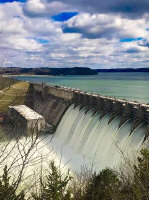Water Resources

“Springs and the Pioneer Settlement of Kentucky.” In Shaped by Water: Kentucky’s Watersheds, Landscapes, and People, Brian D. Lee, Alice Jones, Dan Carey, and Stephanie McSpirit, eds. (Lexington: Univ. Press of Kentucky, 2017): 27-39. The pioneers who came to Kentucky beginning about 1773 to claim land and start a new life had two main criteria used to select tracts: the fertility of the soil and the presence of a good karst spring to serve as a water supply. In the early days, when there was considerable hazard of Indian attack, the settlers built fortified houses known as stations, and every known station in the Inner Bluegrass was laid out at a good spring. The same was true for communities; modern cities and towns in central Kentucky, such as Lexington, Georgetown, and Versailles, were nearly all founded at a spring. This book chapter provides a detailed discussion of pioneer land claiming in Kentucky, focusing on the springs they chose.
“Water Resources.” In Clark’s Kentucky Almanac 2006 (Lexington, KY: Clark Group, 2006): 336-342. This essay examines the surface and groundwater resources of Kentucky. Rivers and lakes are individually described, including a discussion of impoundments and hydroelectric power, and tables are provided listing (1) the major rivers, their tributaries, lengths and drainage areas, and (2) the major lakes, identifying the impounded river, total surface area, shoreline perimeter, and dam including dam height, date of construction, and generating capacity.
“Community Self-Help Activism in Water/Sewer Development: Case Studies from McDowell County, West Virginia and Letcher County, Kentucky.” Appalachian Journal 33 (Fall, 2005): 54-77. In many of what are considered to be “distressed” counties of the Appalachian region, among the most pressing issues are the lack of dependable potable water and effective wastewater treatment. Water quality is especially problematic in coal mining regions, often being contaminated with iron, sulfur, barium or other undesirable substances. Provision of public service to households without sewer connections increases water use and production of untreated wastewater. Water and sewer projects are enormously expensive in the mountainous terrain of Appalachia, and federal and state programs only provide limited funding. This article provides case studies for different approaches taken by three Appalachian communities where citizen activism helped to overcome obstacles.
The Search for Water: Self-Supply Strategies in a Rural Appalachian Neighborhood. Thesis, University of Kentucky, 1996. An investigation of northeastern Rockcastle County, Kentucky, evaluated water supply strategies of a rural population where a public water system was lacking. Water supply sources included rain water collection systems, wells, natural springs, purchase from vendors, bottled water, and transport of water from local springs. Water supply practices were complex and many households used multiple sources. Source choice was dictated by individual perceptions of relative accessibility, quality, and reliability. Spring water was rated by respondents as best and public system water as poorest. Households with sources perceived as reliable and good quality were resistant to obtaining public water service, whereas those having poor supplies were very willing to connect even at high cost. Understanding existing patterns of supply and beliefs concerning water can assist in regional water-supply planning.
“Water Supply and the Early Development of Lexington, Kentucky.” Filson Club History Quarterly 67 (October, 1993): 431-461. This article traces the evolution of water supply for the city of Lexington, beginning in the pioneer era when the community location was selected on the basis of a natural spring to be used as a public source. Additional springs within community bounds were also developed and used. As the city population grew, springs were no longer sufficient and citizens began to depend on wells and rainwater collection, the latter especially favored after a series of cholera epidemics during the nineteenth century bred mistrust of groundwater. By the latter part of the century, city growth and the need for a piped public system required construction of a reservoir, and during the early twentieth century, construction of pipelines to the Kentucky River.
“Three Kentucky Springs.” Journal of Spelean History 21 (Jul-Dec, 1987): 47-54. This article provides brief histories of three historically significant springs of the Inner Bluegrass region: Royal Spring of Georgetown, and McConnell’s Spring and Maxwell Springs, both of Lexington. Royal Spring is the largest spring of the Bluegrass, and was the site of a pioneer station prior to the 1775 founding of Georgetown. It has served as the community’s primary water supply source to the present day. McConnell’s Spring was the site of a explorer’s camp during the pioneer era where the future community of Lexington received its name. Maxwell Springs was a well-known spring located in South Lexington, now covered by buildings of the University of Kentucky main campus.
“The Public Spring of Lexington, Kentucky.” Journal of Spelean History 20 (Jul-Sep, 1986): 66-68. This article provides a brief history of the Public Spring of Lexington, the community’s first water-supply source, which is now buried beneath the city center. During excavations for the Vine Plaza in 1980, the spring was briefly uncovered and wooden pipes from the settlement era were salvaged before construction began that once again buried the spring.







